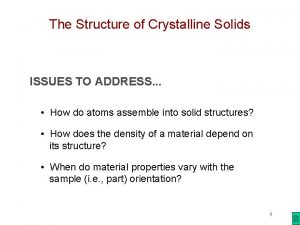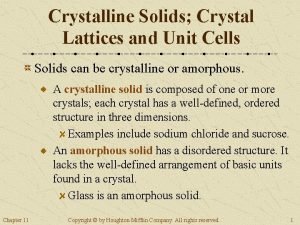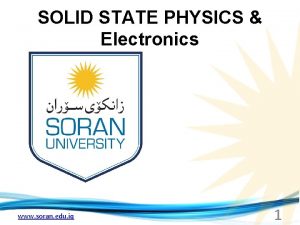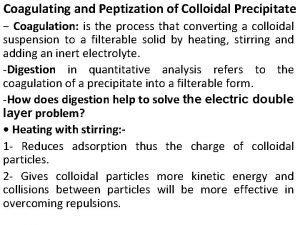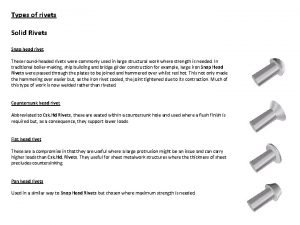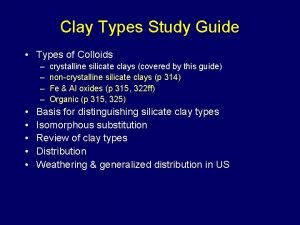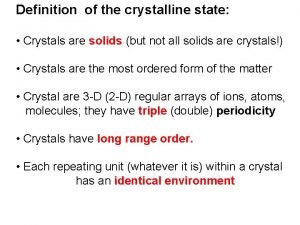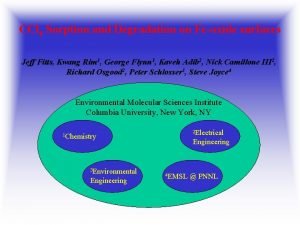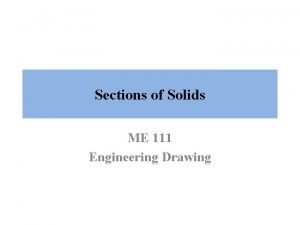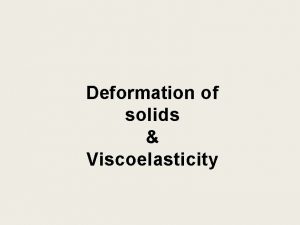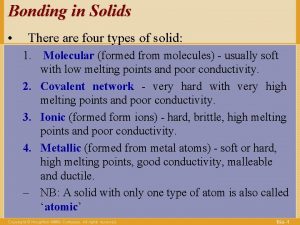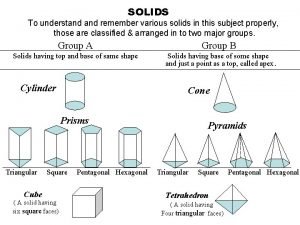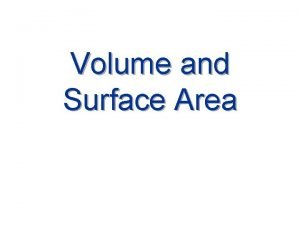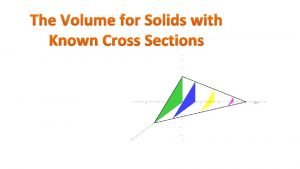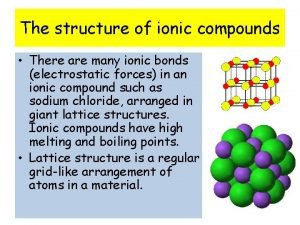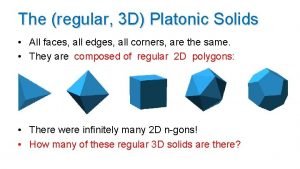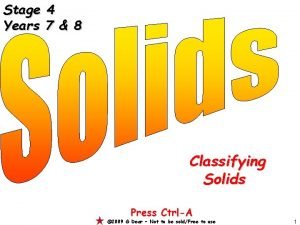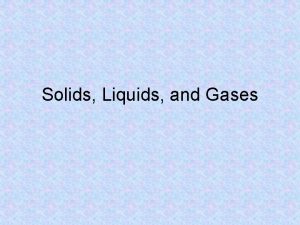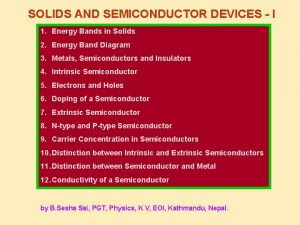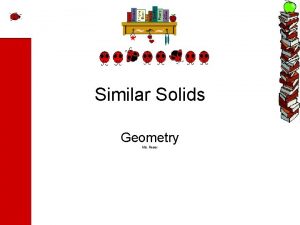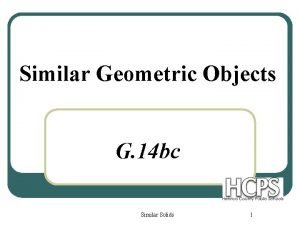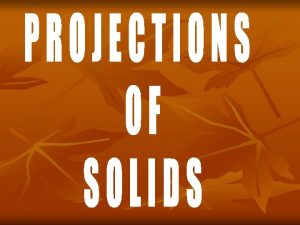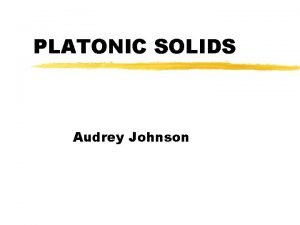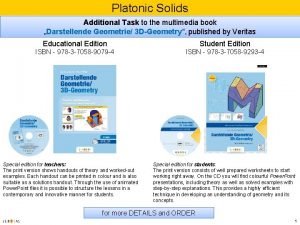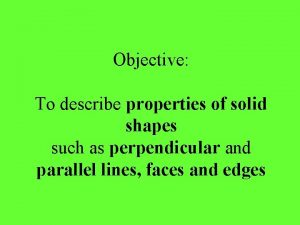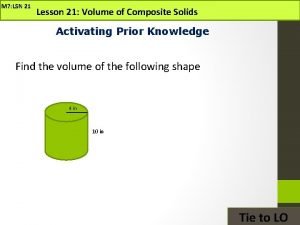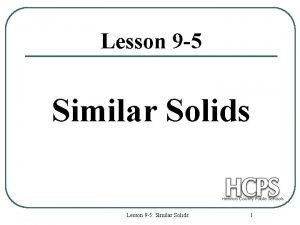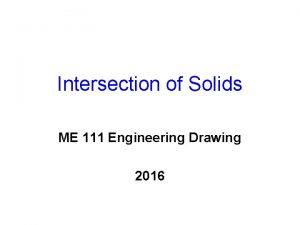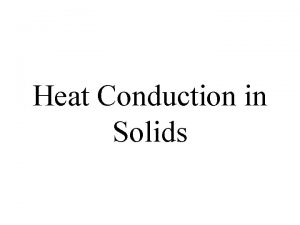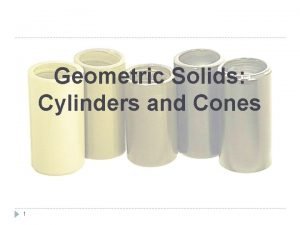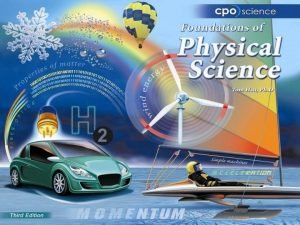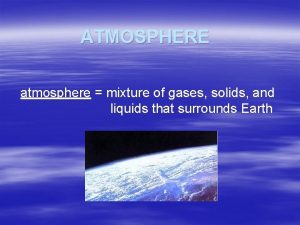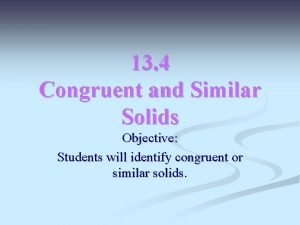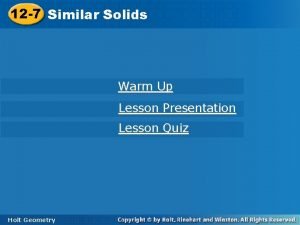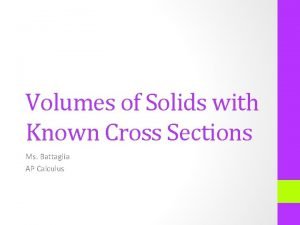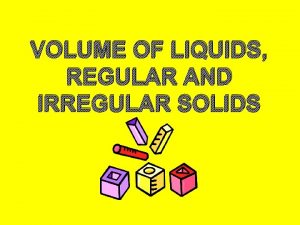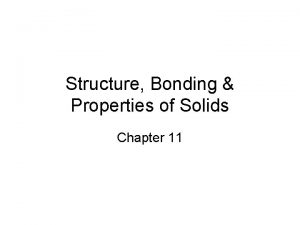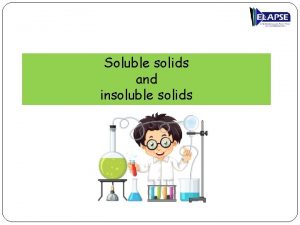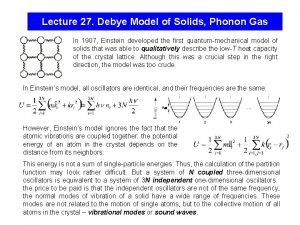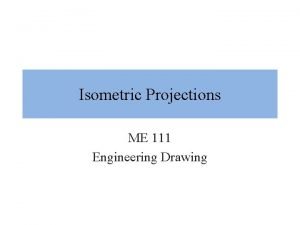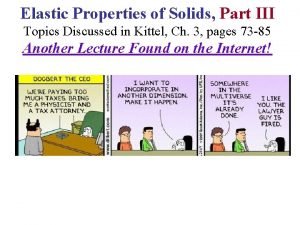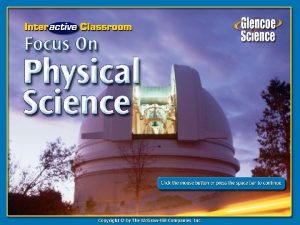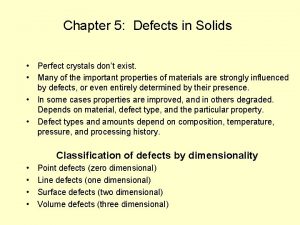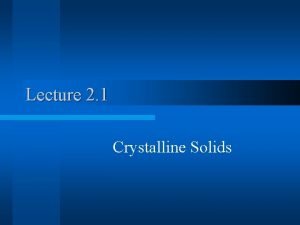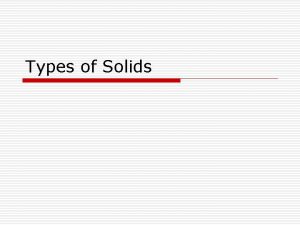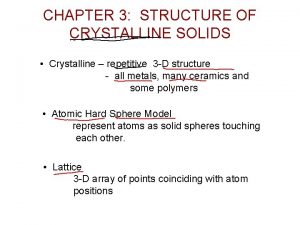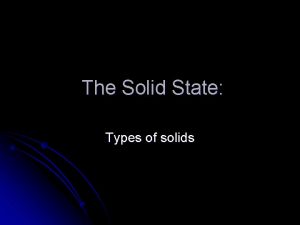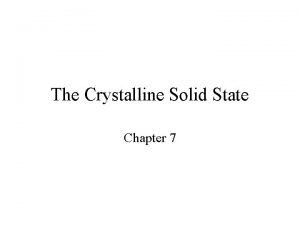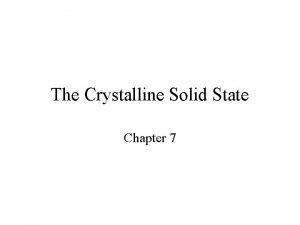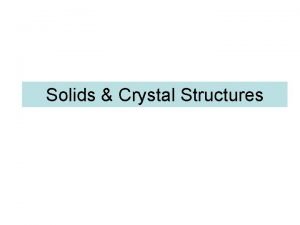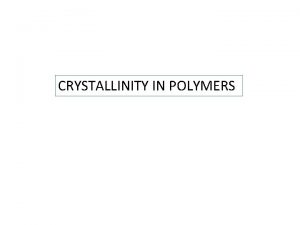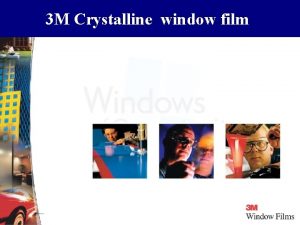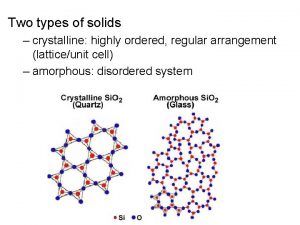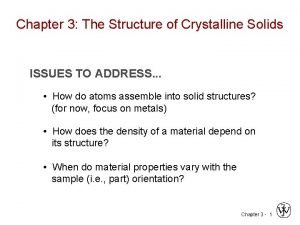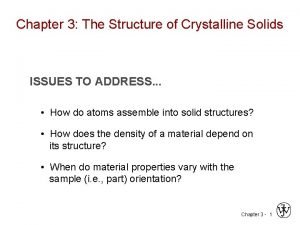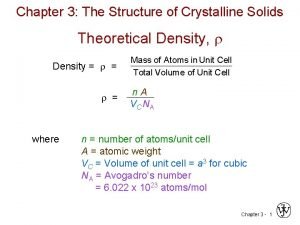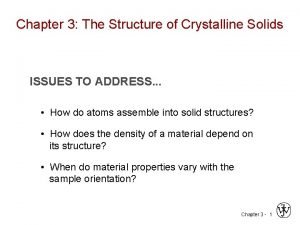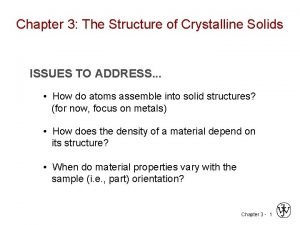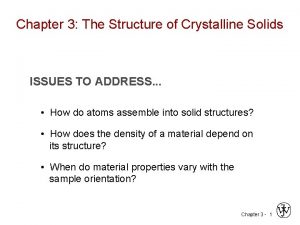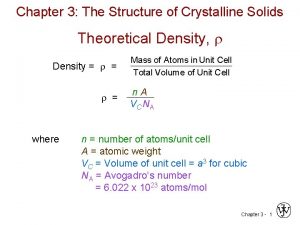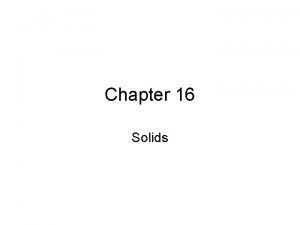Chapter 16 Solids Types of Solids Crystalline solids


















































































- Slides: 82

Chapter 16 Solids

Types of Solids Crystalline solids 1. Shows a sharp melting point. 2. Have a regular, ordered structure composing of identical repeating units having the same orientation throughout the crystal.

Types of Crystalline solids Metallic crystals- are composed of bonded metal atoms; example are Na, Cu, Fe, and alloys. Covalent crystals-consisted of an infinite network of atoms held together by covalent bonds, no individual molecules being present. Example are dismond, graphite, Si. C and Si. O 2.

Types of Crystalline solids Molecular crystals-are composed of individual molecules. Example are Ar, CO 2 and H 2 O Ionic crystals-consisted of an array of positive and negative ions; example are Na. Cl, Mg. O, Ca. Cl 2 and KNO 3

Types of Solids Amorphous solids 1. An amorphous solid does not have a characteristic crystals shape. 2. When heated, it softens and melts over a wide temperature range.

Structure of Metals Simple Cubic (簡單立方) l Hexagonal Closest Packed (HCP) (六方最密堆積) l Face-Centered Cubic (FCC) (面心立方) l Body-Centered Cubic (BCC) (體心立方) l

Closest Packing hcp and fcc The hcp and fcc structures are closely related : they are both based upon stacking layers of atoms, where the atoms are arranged in a closepacked hexagonal manner within the individual layer.

The atoms of the next layer of the structure will preferentially sit in some of the hollows in the first layer - this gives the closest approach of atoms in the two layers and thereby maximizes the cohesive interaction.

When it comes to deciding where the next layer of atoms should be positioned there are two choices - these differ only in the relative positions of atoms in the 1 st and 3 rd layers.

ABABA. . packing sequence of the hcp structure ABCABC. . packing sequence of the fcc structure


Closest Packing hcp and fcc These hcp and fcc structures share common features : (a) The atoms are close packed (b) Each atom has 12 nearest neighbours.

Hcp structure The. . ABABA. . packing sequence of the hcp structure gives rise to a three-dimensional unit cell structure whose symmetry is more immediately related to that of the hexagonallyclose packed layers from which it is built.

l l The unit cell for the hexagonal closest-packed structure has a diamond-shaped or hexagonal base with sides of equal length. The volume is the product of the area of the base and the height of the cell.

c = 4 r(2/3)1/2 a=2 r b=2 r


An actual STM image of a Ni surface. Note the hexagonal arrangement of atoms. This image is the property of IBM Corporation.

Fcc structure The. . ABCABC. . packing sequence of the fcc structure gives rise to a three-dimensional structure with cubic symmetry.

FCC structure



l l Coordination Numbers (CN)=12 Net number of spheres in unit cell =(8× 1/8)+(6× 1/2)=4

Bcc structure l l The bcc structure has very little in common with the fcc structure - except the cubic nature of the unit cell. Most importantly, it differs from the hcp and fcc structures in that it is not a close-packed structure. The structure of the alkali metals are cheracterized by a bcc unit cell.

BCC structure


l l Coordination Numbers (CN)=8 Net number of spheres in unit cell =(8× 1/8)+(1× 1)=2


Packing Efficiency For a FCC structure For a BCC structure

Packing Efficiency of HCP Structure l l The unit cell is characterized by three lengths (a, b, c) and three angles (a, b, g). The quantities a and b are the lengths of the sides of the base of the cell and g is the angle between these two sides. The quantity c is the height of the unit cell. The angles a and b describe the angles between the base and the vertical sides of the unit cell.

Packing Efficiency of HCP Structure l l l In the hexagonal closest-packed structure, a = b = 2 r and c = [4(2/3)1/2]r, where r is the atomic radius of the atom. a = b = 90 o and g = 120 o The volume of the hexagonal unit cell: V = 8(2)1/2 r 3

g=120 o a=90 o c = 4 r(2/3)1/2 b=90 o a=2 r b=2 r

X-Ray Analysis of Solids

Bragg equation: nl=2 dsinq

X-ray crystal diffraction

X-ray power diffraction Cu(111) Cu(100)

Band Theory l Consider a molecule with two atomic orbitals. The result must be that two molecular orbitals will be formed from these atomic orbitals: one bonding and one anti-bonding, separated by a certain energy.

Band Theory l If this is expanded to a molecule with three atoms, assuming 1 atomic orbital for each, then the result must be that 3 molecular orbitals will be formed.

• Now , let's take it to 10 atoms. This will produce 10 molecular orbitals: 5 bonding and 5 antibonding. As the number of molecular orbitals increases, the energy difference between the lowest bonding and the highest anti-bondig increases, while the space between each individual orbital decreases.


l Consider a metal with an infinite number of atoms. This will form an infinite number of molecular orbitals so close together they blur into one another forming a band.

Electron sea model



Empty MOs Filled MOs


Fermi Level/ Fermi Energy l l At absolute zero, electrons pack into the lowest available energy states and build up a "Fermi sea" of electron energy states. The top of that "Fermi sea" of electrons is called the Fermi energy or Fermi level. The Fermi level is the surface of that sea at absolute zero where no electrons will have enough energy to rise above the surface.

Metal Alloys l l l Definition: A substance that contains a mixture of elements and has metallic properties. Substitutional alloy Interstitial alloy

Substitutional alloy Definition: Some of the host metal atoms are replaced by other metal atoms of similar size. l Vacancy Diffusion: Vacancy diffusion involves the migration of an atom from a typical lattice position to a vacancy lattice site. l

Vacancy Diffusion Atomic migration by a mechanism of vacancy migration. Materials flow (the atom) is opposite the vacancy flow direction.

Interstitial alloy Definition: The solute metal atoms occupy holes in the close-packed structure of the solvent metal. l Interstitial diffusion: Interstitial diffusion involves the movement of an atom from a typical lattice position to an empty space between the lattice atoms called interstitial site. l

Interstitial diffusion Requires small impurity atoms (e. g. C, H, O) to fit into interstices in host.

Cu/Zn alloy Substitutional alloy Fe/C alloy Interstitial alloy

Covalent crystals Network Atomic Solids: Carbon 碳 60 奈米碳管



TEM micrographs of SWNTs

Superconductivity l l l Electrical resistance is zero. No wasted heat energy 1911 mercury-4 K Niobium alloy – 23 K High-temperature superconductor-perovskites YBa 2 Cu 3 Ox (x=6. 527)

Kelvins Highest known superconducting temperatures

The structure of quartz

Examples of silicate anions, all of which are based on Si. O 44 - tetrahedra


Two-dimensional reprentations of (a) a quartz crystal and (b) a quartz glass.

Semiconductors l l l A silicon crystal at any temperature above absolute zero temperature, there is a finite probability that a few electron can cross the gap at 25 o. C. The lattice will be knocked loose from its position, leaving behind an electron deficiency called a “hole". At high temperature, more energy is available to excite electrons into the conduction band.

Intrinsic Semiconductor

Silicon Energy Bands

The Doped Semiconductors l The addition of a small percentage of foreign atoms in the regular crystal lattice of silicon or germanium produces dramatic changes in their electrical properties, producing n-type and ptype semiconductors.

The addition of penta-valent impurities such as Sb, As or P contribute free electrons, greatly increasing the conductivity of the intrinsic semiconductor.

The addition of trivalent impurities such as B, Al or Ga to an intrinsic semiconductor creates deficiencies of valence electrons, called "holes".


Ionic Solid l l l Stable High melting substance Held by the strong electrostatic forces that exists between oppositely charged ions.


Octahedral Hole l An octahedral hole lies at the center of six equidistant spheres whose centers define an octahedron.

This result shows that an octahedral hole in a closest packed structure has a radius that is 0. 414 times the radius of the packed spheres.

Tetrahedral Holes l A tetrahedral hole lies at the center of four spheres whose centers form a tetrahedron.

In a closest packed structure, a tetrahedral hole has a radius that is 0. 225 times the radius of the packed spheres.

Cubic Holes



Structure of Actual Ionic Solid

The Structure of Alkai Halides

Lattice Defects Point Defects l Schottky defects: A crystal with missing particles l Frenkel defect: Crystals in which particles have migrated to nonstandard positions.

 Lattice basis
Lattice basis Atom and its structure
Atom and its structure Crystalline solids
Crystalline solids Amorphous vs crystalline
Amorphous vs crystalline Is cotton candy anisotropic
Is cotton candy anisotropic Crystalline substances
Crystalline substances Is fudge a crystalline candy
Is fudge a crystalline candy Crystalline solid
Crystalline solid Mechanical entrapment in gravimetric analysis
Mechanical entrapment in gravimetric analysis Difference between colloidal and crystalline precipitate
Difference between colloidal and crystalline precipitate Difference between colloidal and crystalline precipitate
Difference between colloidal and crystalline precipitate Difference between occlusion and mixed-crystal formation
Difference between occlusion and mixed-crystal formation Snap head rivets
Snap head rivets Crystalline solid and amorphous solid
Crystalline solid and amorphous solid Crystalline silicate clays
Crystalline silicate clays Crystal state
Crystal state Crystalline solid
Crystalline solid Destiny 2 crystalline formations
Destiny 2 crystalline formations Crystalline solid
Crystalline solid What are two types of solids
What are two types of solids Three types of solids
Three types of solids Section of solids engineering drawing
Section of solids engineering drawing Viscoelasticity
Viscoelasticity Four types of solids
Four types of solids List the various types of solids in engineering drawing
List the various types of solids in engineering drawing Sections in engineering drawing
Sections in engineering drawing Chapter 14 solids liquids and gases worksheet answers
Chapter 14 solids liquids and gases worksheet answers Kinetic molecular theory of liquids and solids
Kinetic molecular theory of liquids and solids Chapter 11 - states of matter: liquids and solids
Chapter 11 - states of matter: liquids and solids Surface area of solids
Surface area of solids Normal total solids dog
Normal total solids dog Solids facts
Solids facts Expansion of solids liquids and gases examples
Expansion of solids liquids and gases examples Volumes of solids with known cross sections
Volumes of solids with known cross sections Why are ionic compounds brittle?
Why are ionic compounds brittle? Platonic solids 4d
Platonic solids 4d Right square prism
Right square prism Buoyancyability
Buoyancyability The attraction between particles gives solids a definite
The attraction between particles gives solids a definite Formation of energy bands in solids
Formation of energy bands in solids Solid
Solid Similar solids
Similar solids Similar solids
Similar solids Solid diagram particles
Solid diagram particles Radius ratio of ionic solids
Radius ratio of ionic solids Orthographic projection of pyramid
Orthographic projection of pyramid Characteristics of platonic solids
Characteristics of platonic solids Archimedian solids
Archimedian solids Kepler-poinsot
Kepler-poinsot Shapes with 6 sides
Shapes with 6 sides Mass of solid liquid and gas
Mass of solid liquid and gas Lesson 21 7.3
Lesson 21 7.3 Similar solids definition
Similar solids definition Intersection of solids
Intersection of solids โจทย์ heat transfer พร้อมเฉลย
โจทย์ heat transfer พร้อมเฉลย Geometric solid definition
Geometric solid definition Formula for cylinder
Formula for cylinder Volumes using cross sections
Volumes using cross sections Why is gas easier to compress than a liquid or a solid
Why is gas easier to compress than a liquid or a solid Composite solid examples
Composite solid examples Composite solid
Composite solid General properties of solids
General properties of solids Examples of solids liquids and gases pictures
Examples of solids liquids and gases pictures Similar figures
Similar figures Solids facts
Solids facts Solids in the atmosphere
Solids in the atmosphere Congruent solids definition
Congruent solids definition Similar solids example
Similar solids example Volumes with cross sections: squares and rectangles
Volumes with cross sections: squares and rectangles Irregular solids
Irregular solids Adhesive force
Adhesive force Covalent molecular and covalent network
Covalent molecular and covalent network Soluble solids definition
Soluble solids definition Solids in contact
Solids in contact What is mixed liquor suspended solids
What is mixed liquor suspended solids Phonon gas model
Phonon gas model Isometric view of triangle
Isometric view of triangle Interpenetration of surfaces
Interpenetration of surfaces Filtering solids from liquids
Filtering solids from liquids Elastic properties of solids
Elastic properties of solids Liquids and solids menu
Liquids and solids menu Lesson 1 thermal energy and the behavior of matter
Lesson 1 thermal energy and the behavior of matter Point defects in crystals
Point defects in crystals

